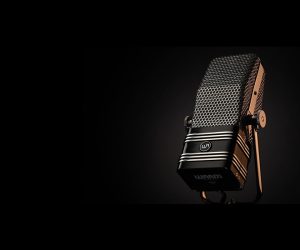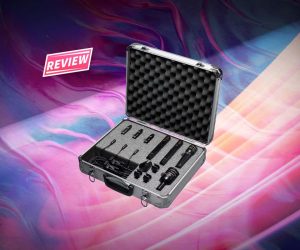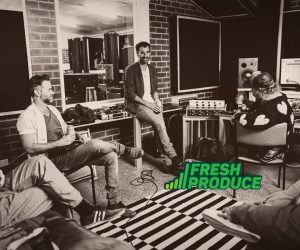
Miking the Madness: Sound for Mad Max Fury Road
Sound recordist Ben Osmo spent six months in Namibia miking up trucks, explosions, mad mutterings, and collisions.
How do you mic up 20 tonnes of nitro-powered War Machine?
Good question.
How do we send a guide music track to the flame-throwing guitarist on the back of the Doof Wagon, when he’s ‘fanging it’ across the Namibian wastelands?
Erm… yup, that would be a good question as well.
And we’ll need usable dialogue from eight actors stuffed inside the rusty cabin of a tanker that might be 3km away from your recorders.
Uh huh. Can I get back to you on that one?
Sound recordist Ben Osmo first started having these head-scratching conversations with Mad Max director George Miller more than 10 years ago. The production was put on hold when the Aussie dollar plummeted. Fast forward to 2013 and the technology began catching up to the vision for the movie. Still, when Ben and his team decamped to the South West coast of Africa for a gruelling six-month desert shoot, there were just as many unknowns as there were knowns.
SCRATCHING PLAN A
Plan A was for Ben to be sitting in the sanitised comfort of an OB-style truck, making tweaks to finely tuned levels coming from DPA lavs on Lectrosonics packs, RF’ed back to base as the production would roll back and forth past him in the desert.
Ben Osmo: “In the original brief the vehicles might drive 500 metres to a kilometre away from us. In other words they might travel 1, 2, 3km-max, then stop. We did the first test and our RF setup gave us a good solid range of about 4km… but they kept going! They had this endless flat expanse in front of them so they kept driving and kept shooting, at times they were 7km away!”
Bang. All bets were off. The feet-up, OB swaggin’ wagon wasn’t going to do the trick. Ben needed to get himself closer to the action. What he needed was an audio production pursuit vehicle — if such a thing existed.
Instead, he got a hard-riding Mitsubishi Delica bongo van. “The boys dubbed it the Osmotron.”
In it Ben piled his Sound Devices 788 field recorders, his treasured Swiss Sonosax desk, his Lectrosonics receivers and more.
Ben Osmo: “Fortunately the 788s record to CF cards and solid-state drives, because hard drives were not going to handle the bumpy ride. I also have CL8 digital interfaces on the 788s with the big rotary knobs. But here’s the thing: when we took off in the Delica for the first time it was so bumpy I simply could not touch a single thing. If I reached out to the CL8 pots I could just as easily have whacked up the gain to 11. There was no hope of making any fine adjustments. It was just a case of setting levels once in anticipation of the action and then hanging on.”
The mental image I have is of Ben with his headphones on, bouncing across the desert at speed, hoping everything would hold together. So much for the glamour of ‘Hollywood’. Worse still, he was also supplying playback for the aforementioned Doof Wagon, so iOTA (actor/muso and flame-throwing guitarist) and his drummer boys could have a guide track in their ears when the vehicle armada was on the march.
Ben Osmo: “Again, the first time we tried this, I had iOTA’s temp music on my laptop running from ProTools via an MBox. No dice, the hard drive was skipping — even when I had the laptop cushioned on my lap. I thought I’d run the audio out my headphone output to see if that improved matters. But it didn’t. And I saved the music to iTunes but that didn’t help either. So in the end, playback was coming out of my iPod which I was waving around above my head trying to keep everything steady.”

I thought I’d pull out my old Nagra 4.2 reel-to-reel recorder to see how a bit of tape compression at 15ips would sound on the crash and explosion
MIKING THE WAR RIG CABIN
At the risk of painting Ben Osmo as some kind of comedic Carry On Recording character in the desert, I should let him explain how he and his team solved the principal technical conundrum: how to mic and record eight actors in a fast-moving truck cabin where distance is an issue, ambient noise is punishing, and the fact your trying to send RF from a rusty steel cage is also a big problem. The solution deserves a round of applause:
Ben Osmo: “There are eight principal cast inside the War Rig cabin and they were fitted with Lectrosonics SMV or SMQV transmitters with DPA 4063 lapel mics. There was an antenna hidden inside the cabin with a coax cable to the interior of the tanker. In the road case hidden in the tanker were two Lectrosonics Venues which had 12 outputs to 12 x UM400 transmitters. The RF output was multiplexed to a RF combiner/booster specially designed by RF engineer Glen English in Canberra. That one coax output then went up the inside of the War Rig and we hid a transmitter aerial on top of the truck above all the metal so we could have 360° line of sight. All this was in a ruggedised road case with a Meon UPS. In the back of the case was a cooling system, as it got to above 50°C and it was very dusty inside the tanker. We called the road case the ‘Sputnik’. There was a 10kW generator in each War Rig for special FX and the lighting departments and sound, so I was able to tap into it to run the Sputnik. I should pay special tribute to Greg Roberts from Lateral Linking for helping me get to this solution.”
KEEP TRUCKING
Miking and recording dialogue was vital. George Miller needed to hear the performances and the editors needed a mix of the dialogue for the rushes. But everyone understood that none of it was going to make it to the final mix. The engine noise was deafening.
But the vehicles were another story. Like additional lead actors in an ensemble cast, the various apocalyptic hot rods each had their own sound and their own personality… and there was no time like the present to record their sonic signatures.
Ben Osmo: “Sam Sardi, who was our RF guy on team, came up with a cool idea of using magnets to place the lavs. I’ve used Blu-Tack on mics for years — it’s great as a little suspension mount. But Sam pulled magnets out of some old hard drives, put Blu-Tack on one side of the magnet which held the DPA 4063 along with some gaff, which allowed for very quick positioning on the car. They worked a treat.
“We would put mics in the engine bay and near the exhaust. On big, super-noisy trucks you could put a mic somewhere between the exhaust and the transmission to hear the transmission changing up and down. For some of those bigger trucks we used the DPA 4062 lav which has an extremely low sensitivity — it could handle more than 130dB.
“My assistant, Oliver Machin, who’s an accomplished documentary recordist, also spent more than a month recording vehicles independent of the shoot.
“Ollie did a great job. He travelled in the cars strapped in with stunt drivers. He’d have a stereo mic in the cabin, one in the engine, one for the exhaust, the transmission… He’d fill an eight-track recorder with each take at 24-bit/96k. There’d be a take for start up, take off, idle etc.”
Between Ben and Ollie they accounted for some 90 percent of all the vehicle sound in the final mix. Ben reflected on the fact that they weren’t too literal in the mix. Sound Designer, David White, along with re-recording mixers, Wayne Pashley and others, were happy to layer sounds from various vehicles and pitch them up/down as necessary to get what they needed.

MIKING UP EXPLOSIONS
Mad Max: Fury Road is big on explosions. Cars are harpooned and explode. Canyons are detonated. When you see a gasoline explosion plume that rises hundreds of metres in the air, you never question its authenticity. It looks real and sounds real.
Ben Osmo: “You never quite know if you’ve got enough headroom when you mic up a crash or explosion. Normally they’re a one-take affair. I’ll use a dynamic kick drum mic, like an AKG D112 — the condensers can’t really handle the big explosions. Saying that, condensers are useful if you place them far enough away. Some of the wavelengths of these explosions are so low that the further you are from ground zero the better.
“I’ve got a beautiful little Sonosax desk. It was made in Switzerland, has beautiful preamps and very delicate limiters if you need them. I’ll try and run crucial audio through those pres if I can.
“When we were back in Sydney doing the Citadel scenes, we also shot another perspective of the final War Rig crash. I thought I’d pull out my old Nagra 4.2 reel-to-reel recorder to see how a bit of tape compression at 15ips would sound on the crash and explosion. I’ve gotta say, the guys in post do a lot of the work with those explosions.”
A DAY IN THE LIFE
In the isolation of Namibia there was a little bit of Mad Max to be seen on and off camera. It’s hard to imagine a more desolate place to shoot a movie and when you’re commuting in and out of the desert every day for six months, you must question your own sanity at times.
Ben Osmo: “We all lived in a little town about 100km from base camp. The sound guys would pile into a mini bus and be on site around 6.15am for a 7am start. Oliver Machin was in charge of setting global sync which would take some time.
“After breakfast we’d drive from base camp to the technical base camp which might be another 3km away but would only have a handful of the essential vehicles for the shoot.
If I knew iOTA and the drummers were there then we’d rig up their in-ears and I’d also rig up a couple of guide track mics on them. I also put a mic on iOTA so he could converse with George Miller if necessary — even though he didn’t have any dialogue he occasionally needed to communicate with the director. We’d do a sound check with all of them before they were good to go.
“There’d be a detailed call sheet that meant we would know prior to the day which vehicles would be involved in the shoot. From that basis we’d busy ourselves with the job of miking up certain vehicles in the armada.
“Almost every day we’d have to rig the sputniks (the ruggedised road cases with the RF receivers/transmitters) into one of the War Rigs (there were four in use, each in different stages of disrepair).
“The cast would be pre-rigged at their trailers by the costume department with one of our guys helping out. We’d pre-rig mics into Max’s leather jacket. The same with Charlize, the Furiosa character, but she’d wait until she was on set to hook up her transmitter.”


DUSTING OFF
The conditions were extreme and tested the limits of the gear but Ben was pleasantly surprised by the reliability of his equipment, given how much of what he was doing would ‘void warranty’. “We lost a few DPAs that strayed a little too close to the exhaust, and a few needed rewiring after they became involved in a fight scene. But otherwise they performed faultlessly.”
Sennheiser 416 and 816 shotguns, all with some hefty Rycote blimp protection, survived the ordeal.
Ben’s military-grade ‘Sputnik’ cases withstood some serious abuse, cooking in 50° temperatures in the tanker but only shut down when the cooling system shut off thanks to power outages. “One time the generator power went off. The UPS kept it going but the heat rose. The delicate part of the Sputnik was the specially-made RF combiner systems. They needed repairing.”
Dust was kept at bay in the Osmotron and, thanks to the Delica air con, the gear mostly whirred away without missing a beat. “The 788s needed the air conditioning. At times I would wipe the tops with iso wipes to get them cooler.”
MENTAL EFFORT
That was the gear, but what about the stresses and strains on the human beings?
Ben Osmo: “It was hard going for everyone. I did feel quite homesick towards the end. I’m a singer/songwriter and I play guitar and flute. So I teamed up with a few of the other crew and we jammed on a Sunday night at a local pizza joint and let off a bit of steam. A lot of crew and cast came along; it had a great family feeling.
“It was quite hard being cooped up in my van but it was 10 times harder for the camera people and other sound crew in the dust and heat and, at times, the cold. But it was enormously rewarding.”
And the results?
Ben Osmo: “I was at the Sydney film premiere in May and that was the first time I’d seen the final cut. I think some of the mixing decisions were very courageous and it sounded quite extraordinary. There were times when the Max and Furiosa characters would be talking to each other in the war rig, almost at a whisper. Pedants might insist that it’s utterly unrealistic and you wouldn’t be heard over the engine noise. But I say, you instantly felt the isolation and claustrophobia. You were in the truck with them and it sounded great.”


















RESPONSES